Imagine stepping into your bathroom and being greeted by lush foliage, vibrant blooms, and a sense of calmness. Picture the improved air quality, the reduced humidity, and the visual delight of nature’s touch.
Incorporating moisture-absorbing plants into your bathroom creates a visually appealing space, helping absorb excess moisture and improve air quality.
So, let’s dive into a list of bathroom-friendly plants that will have your space feeling fresh and fabulous!
The Significance of Moisture Absorbing Plants in Bathrooms
Bathrooms are notorious for excess moisture due to frequent use and inadequate ventilation. The accumulation of moisture can lead to various problems, including the growth of mold and mildew, unpleasant odors, and even damage to your bathroom fixtures. This is where moisture-absorbing plants come to the rescue, offering a natural and effective solution to these issues.
Improved Air Quality: One of the primary benefits of incorporating moisture-absorbing plants in your bathroom is the significant improvement in air quality. These plants act as natural air purifiers, absorbing pollutants and releasing oxygen, creating a fresh and stimulating environment.
Reduction of Mold and Mildew Growth: Moisture-loving plants can absorb excess humidity from the air, preventing the conditions necessary for mold and mildew to thrive. By reducing moisture levels, these plants help create an inhospitable environment for these unsightly and potentially harmful fungi.
Natural Humidity Regulation: Moisture-absorbing plants act as natural regulators, absorbing moisture when the air is humid and releasing it when it becomes drier. This natural balance creates a more comfortable and stable environment for you and your plants.
19 Bathroom Plants That Absorb Moisture
Now that we understand the significance of moisture-absorbing plants in bathrooms, let’s explore 19 remarkable plant species that particularly absorb excess humidity. Each plant possesses unique characteristics and abilities, making them ideal companions for your bathroom sanctuary.
Orchids
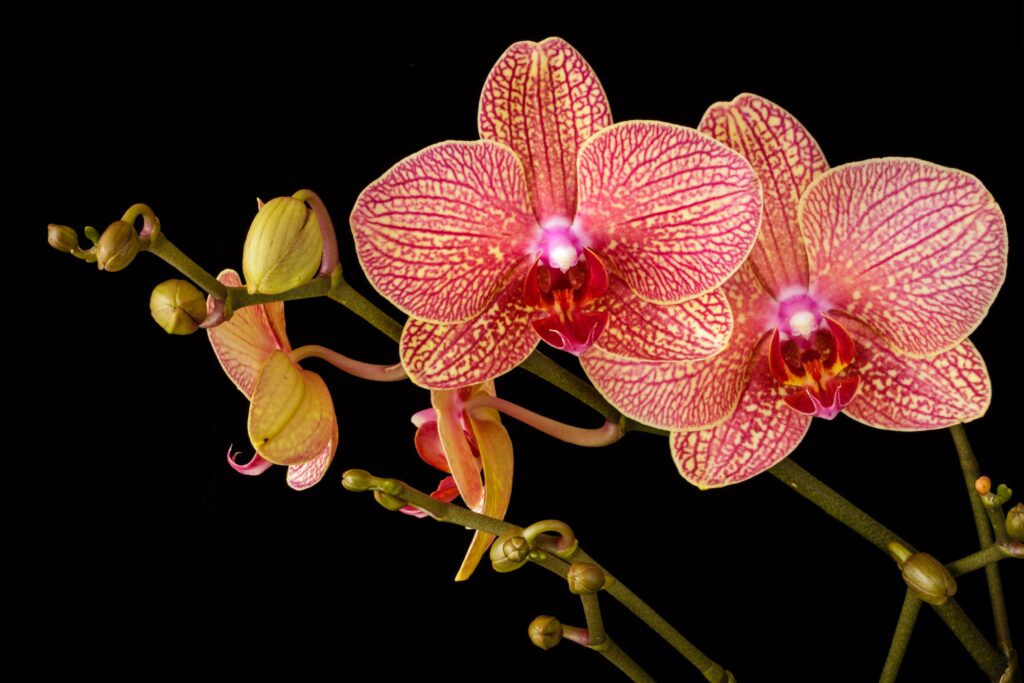
These elegant and exotic flowers add beauty to your bathroom and have moisture-absorbing qualities that help control humidity levels.
Orchids are known for their vibrant and diverse blooms, varying from delicate whites to bold purples. They require bright, indirect light and moderate watering.
Orchids absorb excess moisture from the air, contributing to a healthier and more balanced environment in your bathroom.
Place orchids in a well-draining potting mix and provide indirect sunlight.
Water them sparingly, allowing the roots to dry out between waterings.
Spider Plant

With its cascading foliage and air-purifying qualities, the
Spider Plant, scientifically known as Chlorophytum comosum, is an excellent bathroom choice.
The spider plant features long, arching leaves with green and white stripes. It thrives in bright, indirect light and requires regular watering.
Spider plants are known for absorbing moisture from the air, helping to reduce humidity levels in your bathroom. They also have air-purifying qualities, removing toxins such as formaldehyde and carbon monoxide.
Spider plants prefer well-draining soil and thrive in bright, indirect light. Water them when the top inch of soil feels dry, and be sure not to overwater, as it can lead to root rot.
You may also like Mass Cane Plant Care
Peace Lily
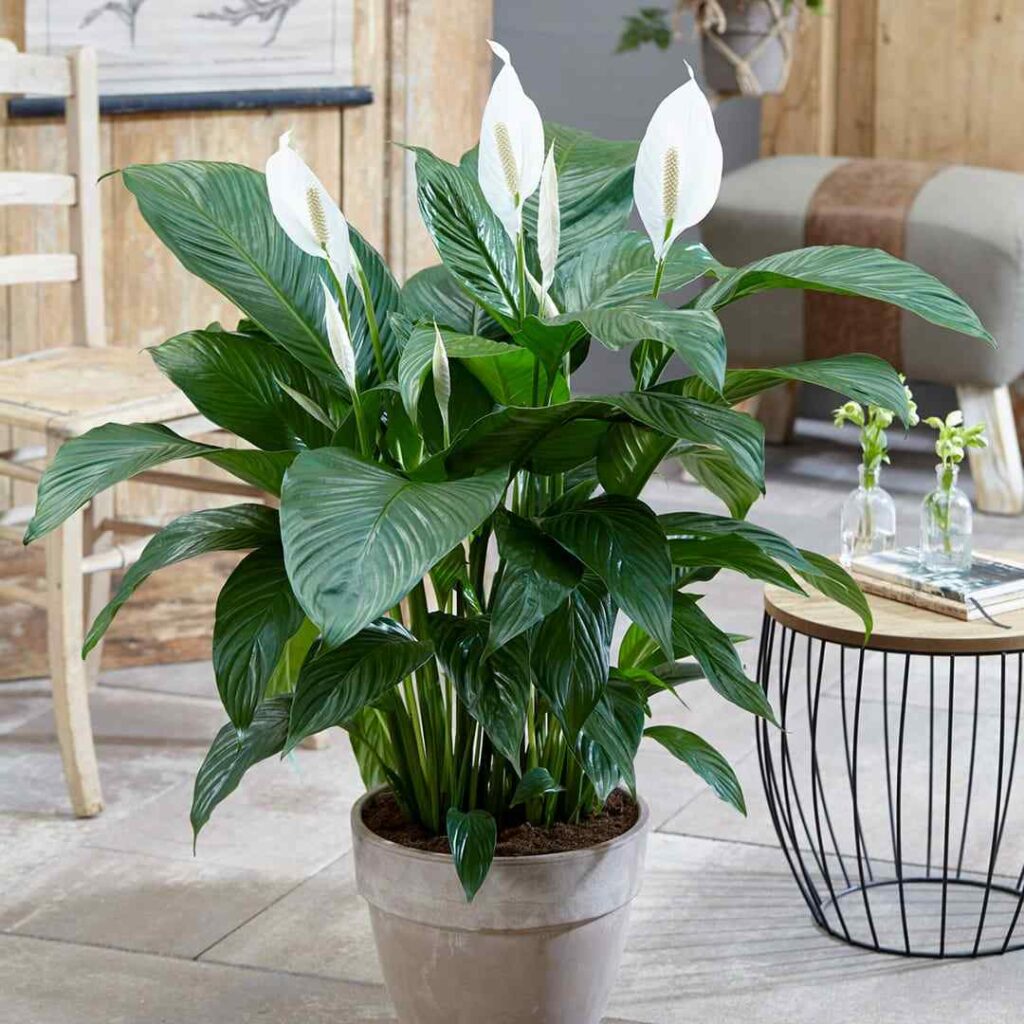
Peace Lily, scientifically known as Spathiphyllum, is a visually stunning plant and an excellent choice for bathroom moisture control.
It features dark green leaves and striking white flowers. Peace Lily prefers medium to low light conditions and requires regular watering.
They are exceptional at absorbing moisture from the air, contributing to humidity regulation in your bathroom. They also remove common air pollutants, making the air cleaner and fresher.
Keep peace lilies in well-draining soil and place them in areas with indirect light. Water them when the soil surface feels dry to the touch.
Boston Fern
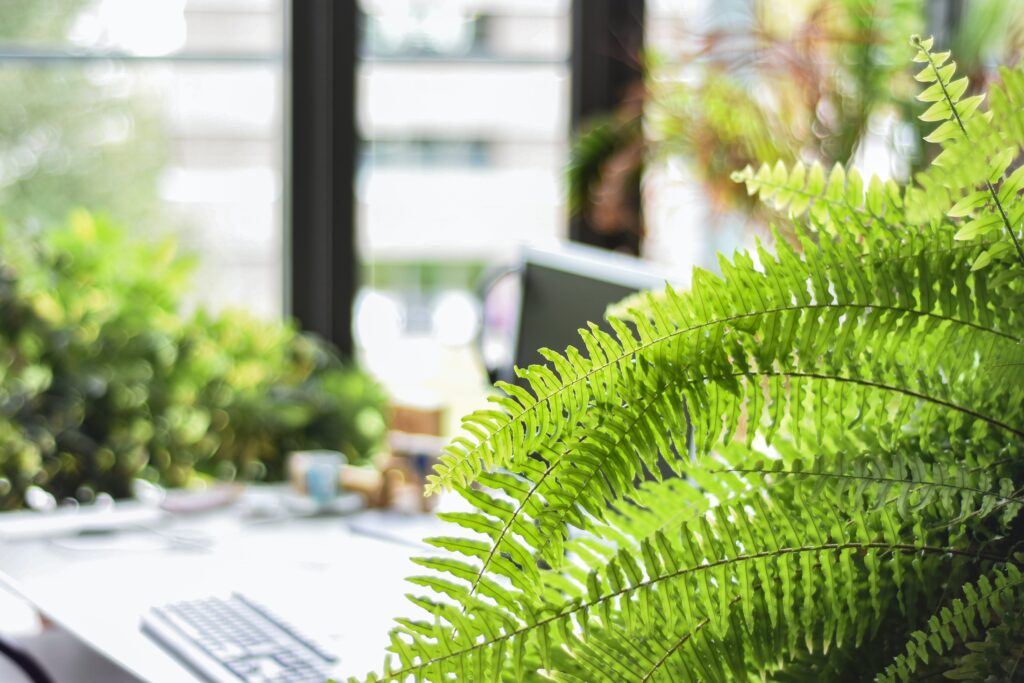
Boston Fern, scientifically known as Nephrolepis exaltata, adds elegance to any bathroom while effectively absorbing excess moisture.
They have delicate, feathery fronds that look lush and full. They thrive in indirect light and prefer consistently moist soil.
Boston ferns are renowned for their high transpiration rates, which release moisture into the air, thus reducing humidity levels. They also help filter out toxins, enhancing the air quality.
Provide Boston ferns with indirect light and moisten the soil. Mist the fronds regularly to mimic their natural humid habitat.
Bamboo
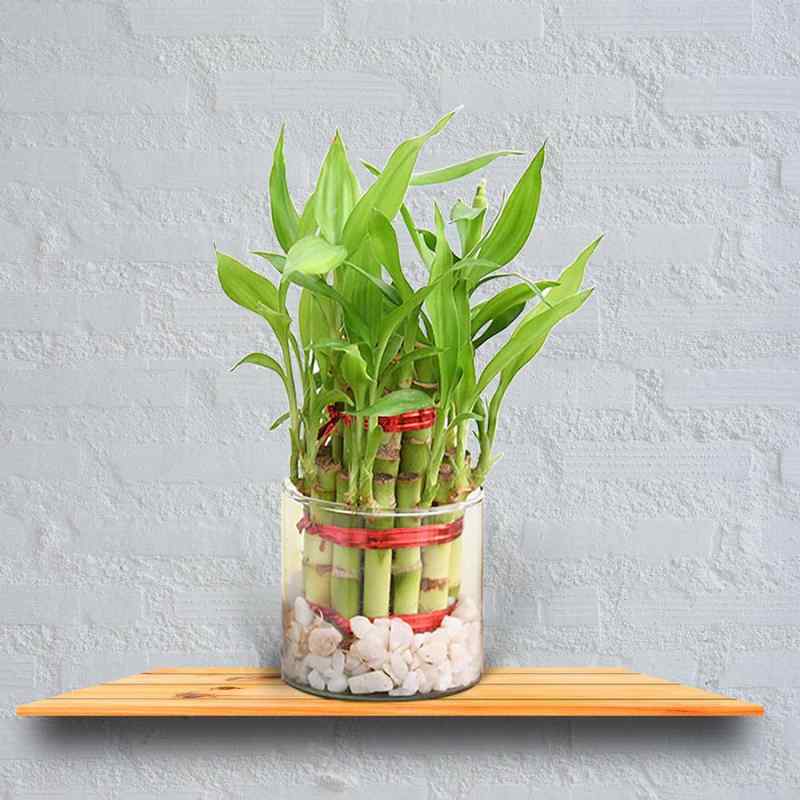
With its graceful, upright stalks and soothing presence, bamboo is a versatile plant that thrives in bathroom environments.
Tall, slender stalks and lush foliage characterize bamboo plants. They require bright, indirect light and regular watering.
Bamboo plants actively absorb moisture from the air, helping to maintain optimal humidity levels in your bathroom. They also have air-purifying qualities, promoting a healthier environment.
Place bamboo plants in a well-draining pot and provide them with indirect sunlight. Keep the soil consistently moist, but avoid overwatering.
Aloe Vera
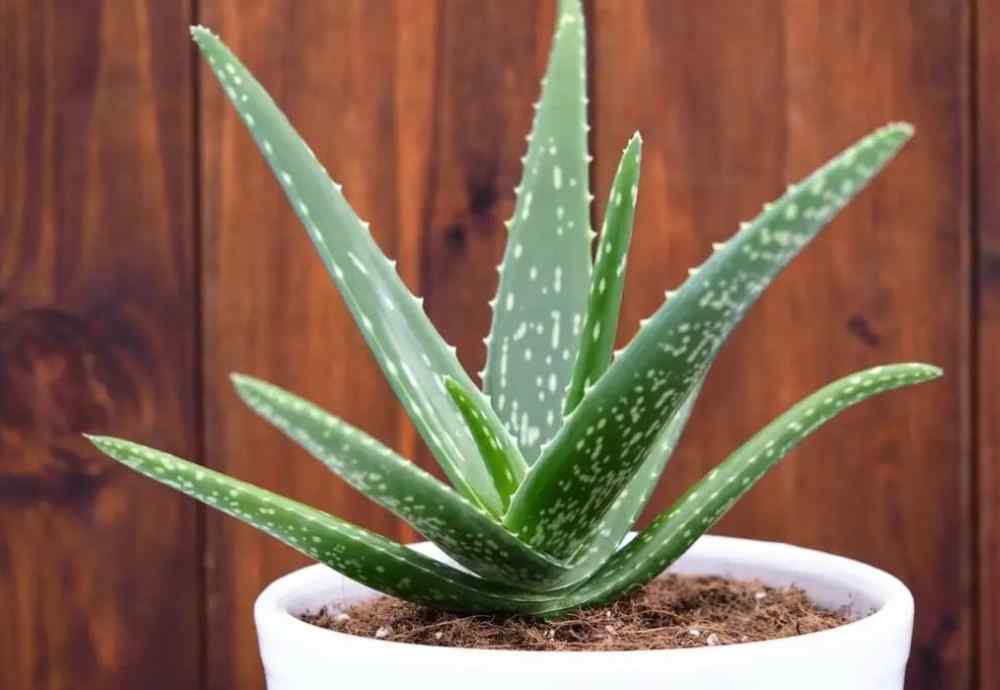
Aloe Vera, scientifically known as Aloe barbadensis, is a succulent plant renowned for its medicinal properties and distinctive appearance and is an excellent choice for both moisture control and aesthetics.
It features fleshy, succulent leaves with serrated edges. It thrives in bright, indirect light and requires infrequent watering.
Aloe vera plants absorb moisture from the air, reducing humidity levels in your bathroom. They also release oxygen at night, making them ideal bedroom companions.
Plant aloe vera in well-draining soil and place it in a spot with bright, indirect light. Water it deeply but infrequently, allowing the soil to dry out between waterings.
English Ivy
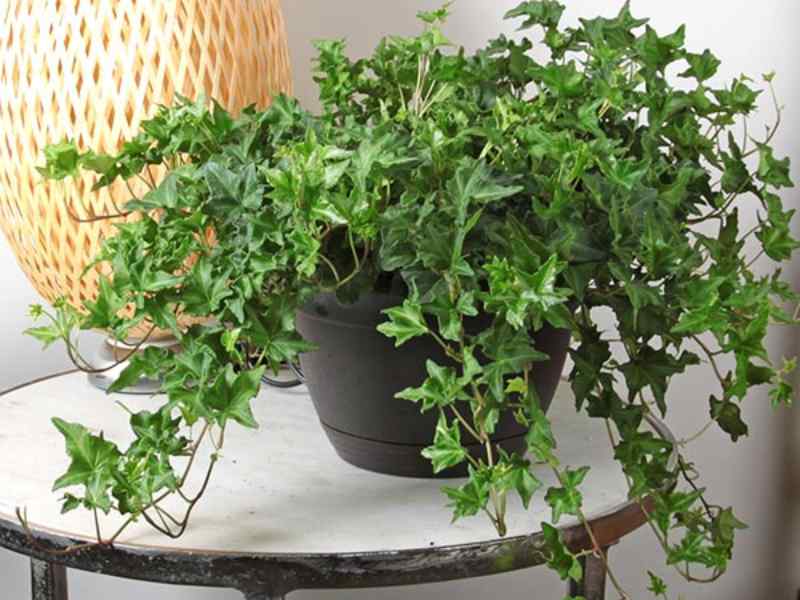
English Ivy, scientifically known as Hedera helix, is an evergreen climbing plant with dark green, glossy leaves that exhibit a distinctive lobed shape.
It is renowned for its vigorous growth and ability to cascade elegantly from hanging baskets or climb walls and trellises.
English Ivy possesses excellent moisture-absorbing abilities, making it a natural choice for humid environments. Its dense foliage helps to reduce airborne pollutants and improve indoor air quality.
To care for English Ivy, provide it with moderate to bright indirect light and keep the soil consistently moist but not soggy.
Regular pruning will help maintain its shape and promote new growth.
Avoid overwatering and provide good drainage to prevent root rot.
Snake Plant
Snake plants, also known as Mother-in-law’s Tongue, have tall, upright sword-shaped leaves usually variegated with vibrant yellow or golden edges, giving them a unique and eye-catching look.
They are excellent moisture absorbers and withstand low light conditions, making them perfect for bathrooms.
Snake plants prefer bright indirect light but can tolerate low-light conditions. Overwatering can lead to root rot, so providing well-draining soil is crucial.
Golden Pothos
Golden Pothos, scientifically known as Epipremnum aureum, is a popular and easy-to-grow houseplant renowned for its attractive, trailing vines and heart-shaped leaves.
The leaves of the Golden Pothos are variegated with vibrant shades of green and yellow, adding a touch of elegance to any indoor space.
This plant is not only visually appealing but also boasts excellent moisture-absorbing abilities.
To care for a Golden Pothos, place it in bright, indirect, or low-light conditions. Water the plant when the top inch of soil feels dry, avoiding overwatering to prevent root rot.
Dracaena
Dracaena is a plant genus encompassing various species commonly grown as indoor houseplants.
These plants are characterized by their upright growth habit and long, lance-shaped leaves.
Dracaenas exhibit various leaf colors and patterns, including shades of green, yellow, and variegated combinations.
While Dracaenas do not possess significant moisture-absorbing abilities like other plants, they still contribute to air quality by releasing oxygen and enhancing humidity.
Care for Dracaenas by placing them in bright, indirect light and watering them when the top inch of soil feels dry. Avoid overwatering, as it can lead to root rot.
Regularly dust the leaves and trim any browning or yellowing foliage to maintain health and appearance.
Spiderwort
Spiderwort, scientifically known as Tradescantia, is a flowering perennial plant cherished for its vibrant, three-petaled flowers and grass-like foliage.
The flowers of Spiderwort can be found in various colors, such as purple, blue, pink, and white, adding a delightful touch to gardens and landscapes. The leaves are long and narrow, often exhibiting shades of green, purple, or variegated patterns.
They enjoy bright, indirect light and efficiently absorb moisture, contributing to humidity control in your bathroom.
Care for Spiderwort by planting it in well-draining soil and providing it with partial shade to full sun exposure.
Philodendron
Philodendrons are known for their heart-shaped leaves and trailing vines.
Philodendron leaves can vary in shape, from heart-shaped to deeply lobed, and come in various shades of green. Some species also have variegated or patterned leaves, adding visual interest.
They thrive in low to bright indirect light and effectively absorb excess moisture, making them popular bathroom choices.
Care for Philodendrons by placing them in bright, indirect light and watering them when the top inch of soil feels dry. They appreciate regular misting and occasional fertilization.
Chinese Evergreen
Chinese Evergreen, scientifically known as Aglaonema, is a popular indoor plant appreciated for its lush, tropical foliage and ease of care.
It features broad, lance-shaped leaves in various shades of green, often with attractive silver, cream, or pink patterns. Chinese Evergreen is known for tolerating low light conditions, making it suitable for dimly lit spaces.
They are excellent at absorbing moisture and can tolerate low light conditions, making them suitable for bathrooms.
To care for Chinese Evergreen, place it in indirect or low light and water it when the top inch of soil feels dry.
Avoid overwatering to prevent root rot.
Boston Fern
Boston Fern, scientifically known as Nephrolepis exaltata, is a popular fern species treasured for its lush, feathery fronds and graceful appearance.
It has delicate, arching fronds with bright green leaflets, giving it a cascading and elegant look.
They actively absorb moisture from the air, reducing humidity levels and contributing to a fresh bathroom environment.
To care for a Fern Plant, provide it with indirect light and consistently moist soil. They prefer high humidity, so misting the fronds or placing the plant on a tray of pebbles filled with water can help maintain optimal moisture levels.
Areca Palm
Areca Palm, scientifically known as Dypsis lutescens or Chrysalidocarpus lutescens, Areca Palm, scientifically known as Dypsis lutescens or Chrysalidocarpus lutescens, is a popular palm tree species that is widely cultivated as an indoor plant.
Its graceful feathery fronds and slender, cane-like trunk characterize it.
The fronds of the Areca Palm are long and arching, with multiple leaflets that give it a lush and tropical appearance.
They effectively absorb moisture, improving the overall humidity balance in your bathroom.
To care for an Areca Palm, place it in bright, indirect light and water it when the top inch of soil feels dry. They thrive in well-draining soil and require regular fertilization to maintain their vibrant foliage. Avoid overwatering, as it can lead to root rot.
Umbrella Plant
Umbrella Plant, scientifically known as Schefflera, is a popular houseplant known for its distinctive umbrella-like arrangement of leaves.
It features compound leaves with multiple leaflets that radiate from a central stem, resembling an open umbrella. The foliage of the Umbrella Plant is typically dark green, glossy, and lush, adding a touch of elegance to any indoor space.
They are excellent moisture absorbers and can tolerate various light conditions, making them versatile for bathrooms.
Care for an Umbrella Plant by placing it in bright, indirect light and watering it when the top inch of soil feels dry. It prefers well-draining soil and benefits from occasional misting to maintain adequate humidity.
ZZ Plant
ZZ Plant, scientifically known as Zamioculcas zamiifolia, is a popular and resilient houseplant cherished for its glossy, dark green leaves and low maintenance requirements.
It features thick, waxy leaves that grow gracefully, and uprightly, making it a visually appealing addition to any indoor space.
The ZZ Plant is known for its excellent moisture-absorbing abilities, as it can tolerate long periods of drought and store water in its rhizomes. This makes it a suitable choice for the bathroom.
Care for a ZZ Plant by sparingly placing it in low to bright indirect light and watering it. Regular wiping of leaves to remove dust will help maintain their glossy appearance.
Rubber Plant
Rubber Plant, scientifically known as Ficus elastica, is a popular and striking indoor plant renowned for its large, glossy leaves and unique appearance.
They absorb moisture and release oxygen, enhancing the air quality in your bathroom.
To care for a Rubber Plant, place it in bright, indirect light and water it when the top inch of soil feels dry. Avoid overwatering to prevent root rot.
These plants prefer well-draining soil and benefit from occasional misting or a pebble tray to increase humidity levels. Regularly dust the leaves to keep them clean and promote photosynthesis.
Bird’s Nest Fern
Bird’s Nest Fern, scientifically known as Asplenium nidus, is a unique and captivating fern species appreciated for its distinctive nest-like appearance and lush foliage.
It features broad, wavy fronds that grow in a rosette shape, resembling a bird’s nest. The fronds are typically bright green and have a glossy texture, adding a touch of vibrancy to any indoor space.
They absorb moisture from the air and contribute to humidity regulation in your bathrooms.
Care for a Bird’s Nest Fern by placing it in bright, indirect light, or partial shade. They thrive in well-draining soil and prefer consistently moist but not soggy conditions.
Mist the fronds regularly to maintain humidity, and avoid exposing them to cold drafts or direct sunlight.
These 19 moisture-absorbing plants offer diverse options to suit your bathroom’s style and lighting conditions. Incorporating them into your bathroom enhances aesthetics and provides a natural solution to combat excess moisture and create a healthier, more balanced environment.
How to Choose the Right Moisture-Absorbing Plants for Your Bathroom
When selecting moisture-absorbing plants for your bathroom, there are several factors to consider:
Light requirements
Assess the amount of natural light your bathroom receives. Some plants, like snake plants and ZZ plants, can tolerate low light conditions, while others, such as ferns or orchids, may require brighter indirect light. Choose plants that match the lighting conditions of your bathroom.
Watering needs
Bathrooms are typically more humid, so choosing plants that can handle higher moisture levels is important. Look for plants that prefer consistently moist soil but are not prone to root rot. Plants like peace lilies and spider plants are good options as they thrive in moderately moist conditions.
Space availability
Consider the available space in your bathroom. If you have limited countertop or floor space, opt for compact plants like air plants or small ferns that can be hung from the wall or placed on shelves. With more space, larger plants such as palm varieties or Boston ferns can create a lush and green atmosphere.
Additionally, it’s important to consider the overall aesthetics and personal preferences when selecting plants for your bathroom. Choose plants that complement the style of your bathroom and create a soothing and inviting atmosphere.
How to Decor Your Bathroom with Moisture-Absorbing Plants
Creative Display Ideas for Your Plants
- Vertical Garden: Create a stunning vertical garden by installing a wall-mounted plant hanger or a hanging trellis. Arrange various moisture-absorbing plants at different heights to add depth and visual interest to your bathroom.
- Terrariums: Consider placing your moisture-absorbing plants in glass terrariums. These enclosed environments provide a unique display and help create a mini greenhouse effect, maintaining higher humidity levels around the plants.
- Plant Stands: Showcase your plants with stylish plant stands in various heights and designs. Opt for stands made from water-resistant materials like metal or plastic to withstand the bathroom environment.
- Grouping Plants: Group several plants together on a windowsill, shelf, or dedicated plant display area to create a lush and cohesive arrangement. Combine different plant heights, textures, and foliage colors for an eye-catching display.
Pairing Plants with Bathroom Aesthetics:
- Spa-like Retreat: Create a serene and spa-like atmosphere by pairing your moisture-absorbing plants with elements such as bamboo accessories, natural stone accents, and calming neutral colors.
- Tropical Oasis: Embrace a tropical theme by incorporating large, leafy plants like the Bird’s Nest Fern or Areca Palm. Pair them with vibrant shower curtains, colorful towels, and tropical-inspired artwork.
- Minimalist Elegance: Choose plants with clean lines and simple foliage, like the Snake Plant or ZZ Plant, for a sleek and minimalist look. Pair them with white or monochromatic bathroom fixtures and minimalist decor.
- Vintage Charm: Select plants that evoke a vintage vibe, such as English Ivy or Spiderwort. Pair them with vintage-inspired mirrors, antique accessories, and soft, pastel color palettes.
Utilizing Hanging Baskets, Shelves, or Wall-Mounted Displays:
- Hanging Baskets: Utilize hanging baskets or macrame plant holders to suspend your moisture-absorbing plants from the ceiling or shower rod. This saves space and adds a whimsical touch to your bathroom decor.
- Shelves and Ledges: Install floating shelves or place decorative ledges near windows or above the toilet to create a dedicated space for your plants. Mix and match plant sizes and heights for a visually appealing arrangement.
- Wall-Mounted Displays: Install wall-mounted planters or create a living wall by arranging moisture-absorbing plants in modular wall-mounted containers. This vertical display maximizes space and adds a unique focal point to your bathroom.
FAQs
Q: What plants absorb moisture in the bathroom?
A: Boston Fern, Peace Lily, and Spider Plant are excellent choices for absorbing moisture in the bathroom.
Q: What is the best plant to absorb moisture in the house?
A: Plants such as Bamboo, Snake plants, and Areca Palm are effective at absorbing moisture in the house.
Q: What is the best plant for mold in the bathroom?
A: Plants like Aloe Vera, English Ivy, and Philodendron can help combat mold growth in the bathroom.
Q: Does aloe vera absorb moisture?
A: Aloe Vera is known for its ability to absorb and retain moisture in its leaves.
Conclusion
As you reach the end of this article, you have learned about 19 varieties of moisture-absorbing plants that thrive in bathrooms.
Now, it’s time to take action and transform your bathroom sanctuary with nature’s green companions. Whether you have a small powder room or a spacious main bathroom, there are plants suited to every space and aesthetic.
So, don’t hesitate! Begin your journey of transforming your bathroom into a green oasis today. Research and choose the plants that resonate with your style and preferences. Experiment with creative displays and integrate them harmoniously with your bathroom aesthetics.
The rewards will extend beyond mere decoration—your bathroom will become a sanctuary where nature thrives, and you can rejuvenate your body and mind.
Embrace the beauty and benefits of moisture-absorbing plants, and let them breathe life into your bathroom. Your sanctuary awaits, ready to be transformed into a haven of freshness, tranquility, and natural elegance.







